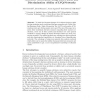Free Online Productivity Tools
i2Speak
i2Symbol
i2OCR
iTex2Img
iWeb2Print
iWeb2Shot
i2Type
iPdf2Split
iPdf2Merge
i2Bopomofo
i2Arabic
i2Style
i2Image
i2PDF
iLatex2Rtf
Sci2ools
80
Voted
KES
2006
Springer
2006
Springer
Alertness Assessment Using Data Fusion and Discrimination Ability of LVQ-Networks
To track the alertness changes of 14 subjects during a night driving simulation study traditional alertness measures such Visual Analog Sleepiness Scale, Alpha Attenuation Test (AAT), and number of Microsleep events per driving session were used. The aim of the paper is to assess these traditional alertness measures regarding their mutual correlations, revise one of them (AAT) and introduce new more general methods to capture changes in human alertness without too many constraints attached. The applied methods are utilizing data fusion methods and data discrimination capabilities via Learning Vector Quantification networks. The advantage of using more general data analysis methods which allows one to assess the validity of proposed alertness measures and opens possibilities to get a more comprehensive knowledge of obtained results.
Alertness | Information Technology | KES 2006 | Study Traditional Alertness | Traditional Alertness |
| Added | 14 Dec 2010 |
| Updated | 14 Dec 2010 |
| Type | Journal |
| Year | 2006 |
| Where | KES |
| Authors | Udo Trutschel, David Sommer, Acacia Aguirre, Todd Dawson, Bill Sirois |
Comments (0)

